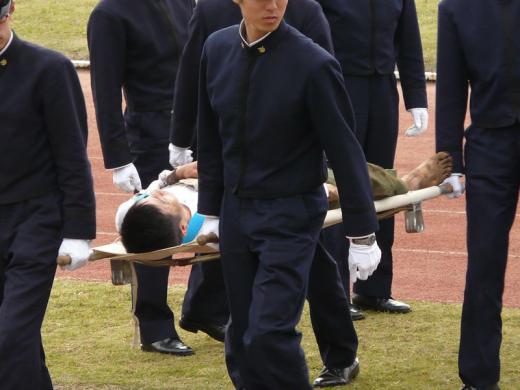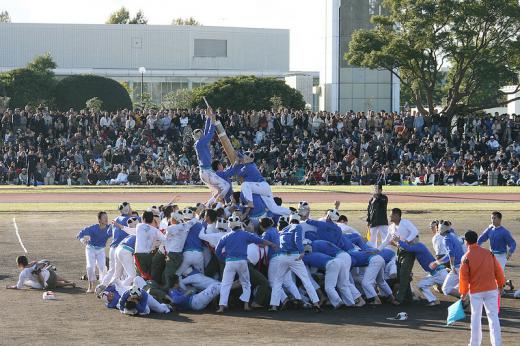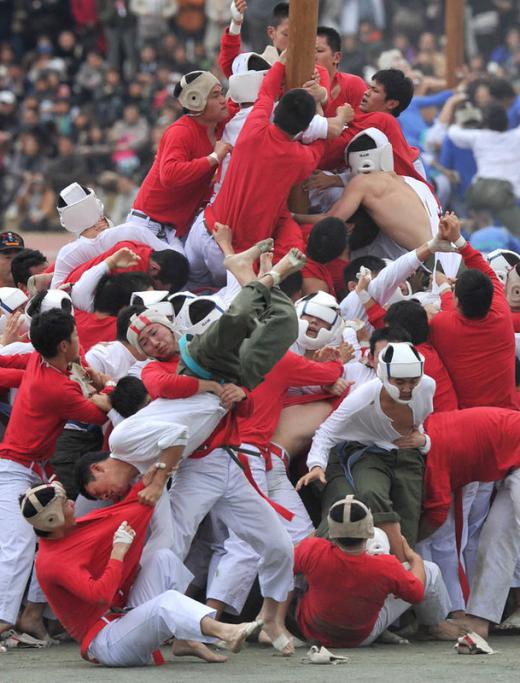Traditionally played during school sports days in Japan, Bo-Taoshi is a full-contact game that literally means “pole-toppling.” It is played between two large teams, with each team attempting to force the other team’s pole towards the ground, out of its upright position.
Origins of Bo-Taoshi
The origins of Bo-taoshi in Japan date back to the late 19th-century, and games such as pole-climbing, rope-climbing, and capture the flag. Some sports historians say that early games of Bo-taoshi involved grabbing a flag from the top of a pole.

Although it is impossible to pinpoint when Bo-Taoshi in its recognizable form was first played, it is thought to have started as a military exercise among cadets at the National Defense Academy of Japan in the 1940s. It is still played there annually on the anniversary of the academy’s founding.
Rules of Bo-Taoshi
As Bo-Taoshi is closely linked to the National Defense Academy of Japan, the academy continues to issue its own rules for this unusual and captivating sport. Other schools and institutions have their own rules and variations involving pole length, duration of the game, size of the teams, uniforms, and protective equipment requirements.

Bo-Taoshi is similar to capture-the-flag (with elements of rugby, American football, martial arts and wrestling mixed in), but on a much larger scale. In Bo-Taoshi, each team consists of dozens of players (traditionally 150 people per team). Of those 150 individuals, 75 serve as offense (attempting to topple the other team’s pole) and 75 as defense (protecting their own team’s pole). The wooden poles used in Bo-Taoshi are typically over 10 feet (3 m) high, but they may be as tall as 16 feet (4.9 m). One end of the pole must be in contact with the ground at all times.

The offensive players form a “scrum” to run at the other team’s defenders, with certain individuals breaking away to charge the opposing pole, attempting to jump over the opposing defenders. A team’s offensive strategy depends on how many attackers will charge the pole at once, and in what order and formation. To identify themselves, offensive players may wear shirts in their team’s color, or go shirtless and wear a colored headband.
There are a variety of defensive positions, including those players who physically support their team’s pole, those who form a defensive circle around the pole, and defenders tasked with blocking the other team’s offense. One defensive player even sits on top of the pole (or otherwise holds onto it) and kicks attackers. Defensive players usually identify themselves by wearing white shirts.
Gameplay
A game of Bo-Taoshi typically lasts 90 seconds or two minutes, with each team attempting to lower the opposition’s pole from its starting perpendicular (90°) position to an angle of less than 30° from the ground. A referee will declare a winner when one of the teams manages to tilt the opposition's pole to within 30° of the ground. If neither team is able to achieve this objective, there is no winner and the game is repeated. Alternatively, a winner may be declared by the referee measuring the distance of each team’s pole from the ground. In some iterations of Bo-Taoshi, a team needs to win several consecutive matches in order to be declared the overall winner.
Dangers and Criticisms of Bo-Taoshi
According to the rules of most institutions, violence such as punching and strangling is not permitted, but aggressive displays of elbowing, scratching, and head-butting often take place. Kicking is extremely common. Not surprisingly, minor injuries are widespread in Bo-Taoshi, while more severe injuries such as fractures and concussions can also occur. In some schools, soft helmets are worn by all participants, in addition to kneepads and athletic cups. Due to the amount of kicking and jumping involved in Bo-Taoshi, shoes are not worn.
These frequent injuries have led many schools to ban Bo-Taoshi from their athletic competitions, despite the traditional belief that taking part in Bo-Taoshi is a valuable experience for building teamwork, sportsmanship, and stamina. For many schools, it is the highlight of their athletic year, with parents, alumni and younger students attending Bo-Taoshi matches, and participants preparing for months for the competition.
Although Bo-Taoshi is an iconic aspect of school life in Japan, it is little known outside of the country. While American sports such as baseball (and, to a lesser extent, American football) have become popular in Japan, it seems very unlikely that Bo-taoshi will be played at American schools or colleges anytime soon.
